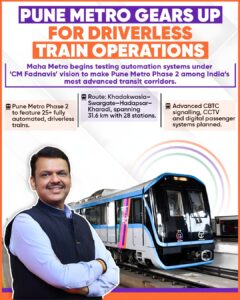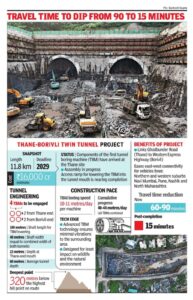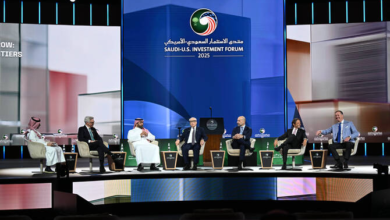Mumbai And Pune 2030 : Maharashtra’s Big Infra Vision Leap!!
Maharashtra plans sea bridges, tunnels, and driverless metros to ease congestion and shape Mumbai–Pune connectivity by 2030.
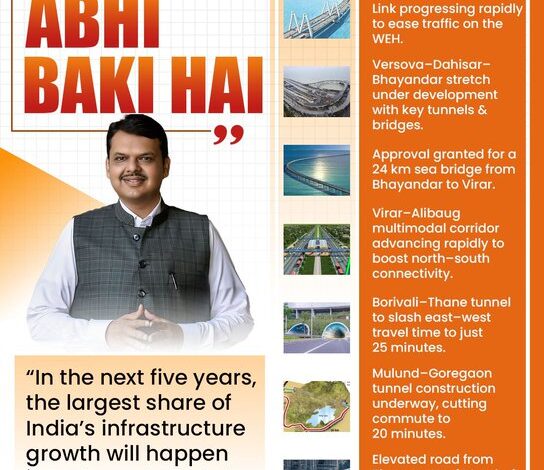
Decongesting Western Express Highway says Maharashtra CM @Dev_Fadnavis . pic.twitter.com/MCfRBLcbh6
— Richa Pinto (@richapintoi) November 10, 2025
Further underscoring Mumbai’s infrastructural leap is the state’s plan for a 70-kilometer underground tunnel network, forming a new express corridor beneath key urban clusters. One of the most anticipated projects, the Virar–Alibaug Multimodal Corridor, will integrate road, rail, and freight connectivity, dramatically improving north–south movement across the western coast. Construction for this mega corridor begins in 2026, with completion targeted before the end of the decade.
In Pune, urban transit is undergoing a parallel revolution. The city’s Maha Metro has successfully initiated testing of India’s next-generation driverless train system. The 31.6-kilometer automated line—scheduled for passenger operations by late 2026—promises a transformative commuting experience powered by real-time AI monitoring, enhanced safety protocols, and seamless integration with bus and feeder services.
Maharashtra CM @Dev_Fadnavis is finalizing plans to construct underground road network to ease traffic congestion in Mumbai and nearby areas. This is a massive step towards congestion free Mumbai. pic.twitter.com/OYwod90ZlE
— Incognito (@Incognito_qfs) November 10, 2025
Fadnavis emphasized that these interconnected projects were part of a broader “Maharashtra 2030” urban development vision focused on creating sustainable, technology-driven smart cities. “Our goal is to reduce travel time across major economic zones, promote cleaner mobility, and build infrastructure that supports Maharashtra’s growth momentum for decades,” he said at the launch event.
Together, these efforts position Mumbai and Pune as national models for next-generation urban planning—where cutting-edge transport, digital innovation, and strategic investment converge to ease the pressures of India’s rapidly expanding metros.
Designed to Decongest !!
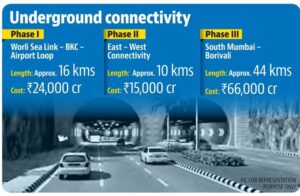
These infrastructure projects are specifically designed to decongest Mumbai and Pune. The major expansions, such as the 10-lane Mumbai–Pune Expressway, sea bridge extensions, and underground tunnels, are intended to reduce bottlenecks, shorten travel times, and support the growing number of vehicles on key routes.
Experts and local officials believe these measures will ease congestion, especially during peak hours and weekends, making long journeys smoother and more efficient for commuters.
Additionally, driverless metro lines and improved multimodal corridors will provide mass transit alternatives and more efficient urban connectivity, which can further reduce reliance on private vehicles and help sustain traffic reduction in the long run.
Shaping Tomorrow: Science Inspires Future-Ready Young Minds!
Shaping Tomorrow: Science Inspires Future-Ready Young Minds!
#Amul & IFFCO Leads India To The Top of Global Cooperatives!
#Amul & IFFCO Leads India To The Top of Global Cooperatives!
#वंदे मातरम भारत के राष्ट्रीय गीत की 150वीं वर्षगाँठ का जश्न
#वंदे मातरम भारत के राष्ट्रीय गीत की 150वीं वर्षगाँठ का जश्न
#वंदे मातरम 150वीं वर्षगांठ: अमर राष्ट्रीय गीत का पूरा इतिहास
#वंदे मातरम 150वीं वर्षगांठ: अमर राष्ट्रीय गीत का पूरा इतिहास
#Starlink Lights Up Rural Maharashtra: Satellites and Synergy
#Starlink Lights Up Rural Maharashtra: Satellites and Synergy

